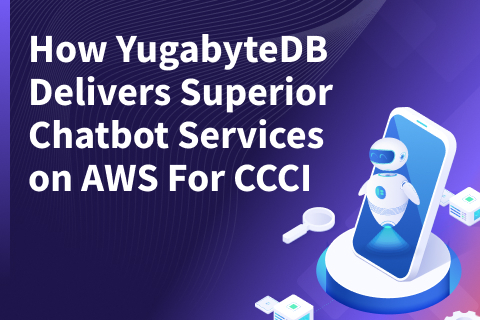How Data and Distributed Databases Drive Fintech Innovation
We recently sat down with Guy Chiarello, Chief Operating Officer at Fiserv, a leading global fintech and payments company offering solutions for banking, e-commerce, merchant acquiring, billing and payments, and point-of-sale. Our chat covered several topics, including innovation in fintech and financial services sectors, the trends he’s keeping an eye on, and why now is the time for another transactional database.
Below is an excerpt of the key points covered during the conversation, or you can watch the full fireside chat below.
Chat Highlights
Q: We’ve previously discussed your career trajectory and that you’ve worked with various databases—from Oracle to Informix. What are your thoughts on “why another database?
Yes, I have used them all—Cassandra, CockroachDB, etc. I’ve been around them all.
Payments is a fast-moving sector. In terms of capital flows and investments, I think that payments and fintech (as a whole) outpace most other sectors. Therefore, if we want to continue moving forward, we must innovate. And with innovation comes competition. Competitors are always just around the corner, and that forces change. Things evolve very quickly.
Most companies have to decide what’s core and what’s not and perhaps reinvent themselves. What you’re doing here at Yugabyte is reinventing the world of transactional processing. Yes, there are some other competitors out there, but you’ve determined what’s core and have decided that you’re going to be the best at it.
You’re going to be global and multi-cloud. You’re going to be state, continuous, and more.
I mean, you’ve done everything that every other great database company has done, but unfortunately, they’ve not pulled it together. You have pulled this all together, and as a result, you’ve simplified my world. So, because I’m in a cycle of building the new and the next generation, it totally makes sense to do it with the next frontier solution set.
YugabyteDB arrived on the scene with very good capabilities at a time when most people are thinking—like I am—about their future. With your cloud-native component, your capabilities, and the problems we’re facing right now, you’re in the perfect storm—in a positive way. That’s why it’s time for another database.
Q: Before we dive into Fiserv and payments and databases, let’s chat about the future. You’ve seen several technology waves hit the market during your career. As you look ahead, what do you think are the most important technology trends?
I’m pretty high on AI in general and let me tell you why. First Data (which was acquired by Fiserv in 2019) was an industry leader with a 40 percent market share in merchant acquiring and payments. At the time, our next competitor had only reached high single digits. So, we were way ahead, and we had data and information that nobody else in the world had.
I’ve always said that what Google did right was to turn a landfill into a goldmine, and I thought we could do that at First Data. My point is that if you can find assets/data that cannot be rivaled, you have a starting point that no one else has. Then if you can figure out how to turn that data into information to make informed decisions and predict the future, you have a significant advantage. So AI, with some ML alongside it, is critically important.
Now, this may not be a future trend, but I want to mention digital. Digital is our new normal.
Businesses are all digital now. For many of the 4,000 banks and millions of merchants we serve, the only way to truly differentiate themselves is through digital ecommerce or omnichannel. So, they’ve decided that digital is their core. For example, it’s tough for you, as a small bank, to compete against JP Morgan, Wells Fargo, or Citibank. You won’t have as many branches. But, if you have the right digital solutions, you can compete with anybody on an equal footing anywhere in the world, regardless of size and scale.
Q: Let’s take it down a level and walk through some of the use cases and environments where you are considering a distributed SQL database like YugabyteDB.
Banking is moving to real time just as trading did. Our clients have told us that they need solutions that support real-time processes. They need high-speed, always-on (24×7) transactional processing capabilities. They need, maybe not global, but certainly regional solutions to their problems.
That means when I process a transaction, it’s reflected in multiple states, in an active/active design, so that I always know the state of my bank, my settlement, my clearing, or my lending.
For banking, it’s really about the movement to digital and all the surrounds we’re building to support that move. It’s about real-time processing, continuous availability, and a continuous knowledge of state.
Then in terms of payments, it’s really like, it’s every country. Cash is in a downward trend, and non-cash is in an upward trend. E-commerce and mobile commerce are off the charts.
To provide the types of client experiences and support the types of transactions we have to, well, that requires much more sophistication. We have to be in the cloud because we have to be wherever our clients want to meet us. If they want to meet us in my private cloud or the public cloud, we have to be able to accommodate that. And it’s great that Yugabyte does both.
That said, I don’t want to have to move the data around so much that it becomes unwieldy. We want to create a sandbox—a container, if you will— that provides the client with data that provides real-time information and insights. Our clients want to do real-time marketing in line with payments. That has to happen in 20 milliseconds. It can’t take three seconds or 12-24 hours. It has to happen in real time. That’s what people want. They want what they want, when they want it, wherever they are in the simplest form possible. And all of that plays to what you’ve created here.
Q: In terms of fraud and security, what do fintechs need, and what does YugabyteDB bring to the table?
We handle 12,000 transactions a second. That’s 12,000 times a second that I have to be perfect. My clients are trusting me 12,000 times a second. From a security point of view, I have to be reliable and responsive. I have to be global in nature. I have to have state at all points in time. Finally, I have to have complete resiliency and continuous operations.
Then in terms of fraud, we’ve seen fraud go off the charts. As we move into more digital-type purchasing patterns, it becomes critically important to know who the person is (or if it is even a person) behind the transaction.
So, the question becomes, how do you either stop fraud or increase authorization optimization? That is what we have to do. We have to render, maybe not terabytes, but certainly gigabytes of information about a person making a purchasing decision in less than a hundred milliseconds and be perfect every time. Because if we decline the payment and we’re wrong, our client doesn’t like us. If we approve it and it’s wrong, the client doesn’t like us because now fraud is attached to that payment.
We are expected to perfect—no false positives, all good transactions. Getting to 100 percent accuracy is very important. How am I going to do that without you? I could build my own database, but that’s not the answer. I’d rather have really smart people—like the team at Yugabyte—do that instead of me.
And, I believe that you’re on the frontier of something very important. The fact that you’re cloud native and have all these other capabilities means that the transactional processing that I do, the information I keep in there, and the integration available to my clients—who are all over the world—just became infinitely easier. That matters.
Q: One last question. As we go forward with our engagement, what metrics will you watch to see if our partnership and efforts are keeping pace with your expectations?
There are several metrics. First, our workloads are only increasing, so we have to focus on getting performance. Performance might not be defined as the traditional TPC benchmarks. It is really around multi-tenancy. The second is availability. Third is true state. When I talk about state I am looking to see if I can have real-time (or certainly near real-time) state in multiple locations to provide either multi-tendency on a broader scale or true regional independence to accommodate onshore data processing for privacy regulations, etc.
Then, finally, there are all the automation features, such as auto-scaling, auto-configuration, self-healing, and things like that. I don’t want to touch this thing.
I view this like an airplane cockpit. If you have ever sat in the cockpit, there are a lot of buttons in there, and you don’t want to touch 95 percent of them. It is the same thing here. Having those buttons and knowing that, if you have a problem, you have them at your disposal, but on a daily basis, you don’t want to touch 95 percent of your “buttons.”
So, auto-configuration, with some dials to turn based on whether it’s a small business, large business, high transaction, low transaction, structured data, unstructured data, etc, is the way I would like to go. I want it to be the best toy I have ever owned, and it just does what it needs to do every day. I want low maintenance and high value.


